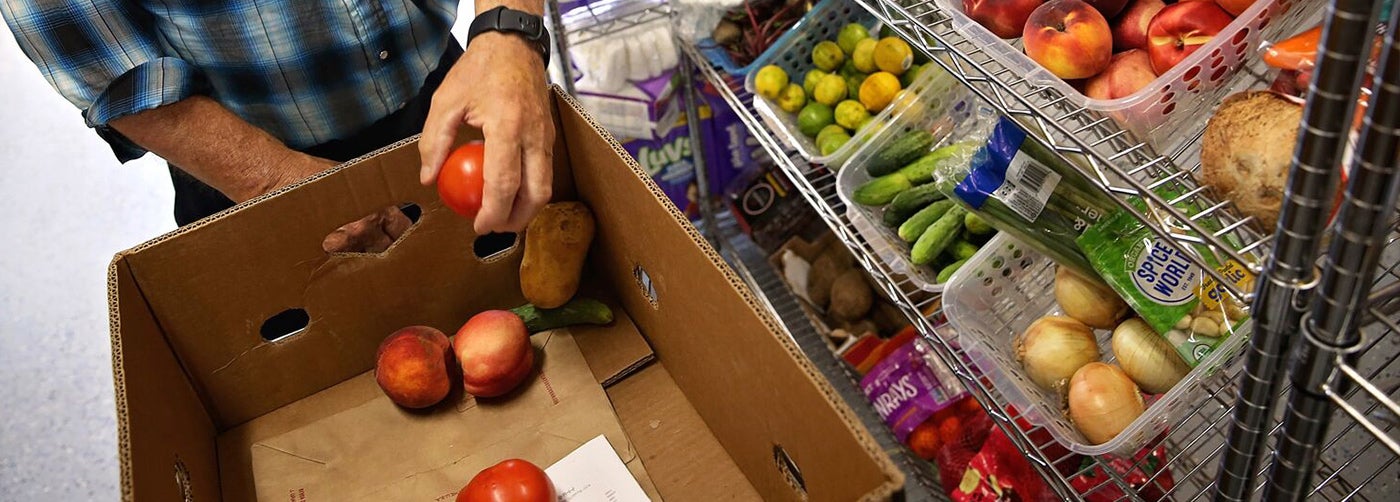
Food Pantries and Hunger Relief
How We Serve
Neighborhood Food Pantries
The Salvation Army has many neighborhood food pantries to provide nutrition and other necessary items for you or your family. A typical visit to one of our food pantries will provide you with a three-to-five-day supply of nutritionally balanced groceries, completely free of charge.
Our food pantries supply nonperishable food and dry pantry goods, with a focus on balanced grains, canned vegetables and fruits, proteins, and pasta. Knowing that these may only provide short-term relief, our food pantries also provide resources to help provide longer-term food support, plus access to different food bank locations.
Food Parcels and Fresh Boxes of Produce
For those with limited time or mobility, our food pantries also offer food parcel services. A typical food parcel includes enough food for about two to three meals a week (depending on household size), packaged and available to pick up curbside or to be delivered straight to your home.
In certain locations, The Salvation Army provides fresh produce in food parcels as well. Fresh items may include potatoes, lettuce, other vegetables, and fruit to provide families with valuable nutrition that dried goods may not always satisfy.
Check with your nearest Salvation Army food pantry for hours of operation to verify if any pieces of identification are needed or to schedule a pickup for food boxes.
Mobile Food Pantries
Mobile food pantries bring essential food to locations that are considered “food deserts,” meaning they lack access to food pantries, grocery stores, and an adequate selection of healthy foods. The Salvation Army’s mobile food pantries use refrigerated vehicles to directly provide food distribution in a drive-thru setup to our clients within food deserts.
Our mobile food pantries may carry a selection of fresh meat, dairy, and produce, as well as other pantry staples and household essentials such as diapers or hygiene products. Also, a team of volunteers and caseworkers helps provide residents with resources to locate other social services available to them through The Salvation Army.
Make sure to check the schedule daily for the most up-to-date locations and times.
Assistance With Applying for SNAP
SNAP (Supplemental Nutrition Assistance Program) — also known as food stamps — is a government program that helps people buy the food necessary for healthy lives. Across the United States, there are 9.5 million families and children using SNAP to buy food. At certain Salvation Army food pantries, our caseworkers and volunteers can give you the resources to apply for SNAP.
Fight Against Food Insecurity
While most U.S. families enjoy a consistent supply of food for a healthy lifestyle, referred to as "food secure," there are instances where households face food insecurity, indicating that their access to adequate food is restricted due to insufficient funds and resources. According to a 2022 study by the United States Department of Agriculture (USDA), households with very low food security reported the following conditions in the annual food security survey:
- 98% reported having worried their food would run out before they had money to buy more.
- 97% reported the food they bought just did not last, and they did not have money to get more.
- 96% reported they could not afford to eat balanced meals.
- 96% reported an adult had cut the size of meals or skipped meals because there was not enough money for food; 87% reported this had occurred in three or more months.
- 95% reported they had eaten less than they felt they should because there was not enough money for food. .
- 65% reported they had been hungry but did not eat because they could not afford enough food.
- 46% reported having lost weight because they did not have enough money for food.
- 29% reported an adult did not eat for a whole day because there was not enough money for food; 22% reported this had occurred in three or more months.
Additional Hunger and Poverty Statistics:
- 12.8% of all American households with children are food insecure.
- 30.3% of households headed by single women are food insecure.
- 22.4% of Black non-Hispanic households are food insecure.
- 20.8% of Hispanic households are food insecure.
- 9.3% of white non-Latinx households are food insecure. .
Stats

Help feed your neighbors in need.
Donating cash or nonperishable food items to a food pantry is vital in ensuring that individuals and families facing hunger have access to the resources they need to thrive, especially during times of crisis.
Other Services

